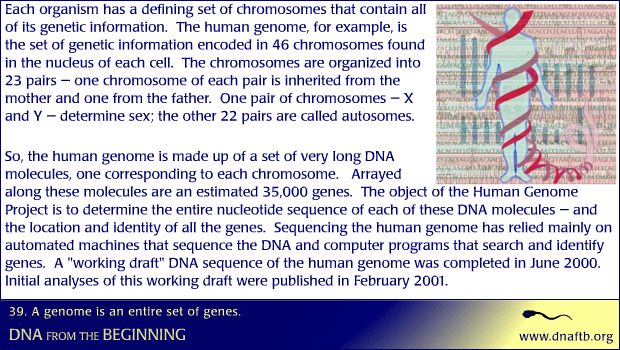Concept 39: A genome is an entire set of genes.

Our genome is a set of long DNA molecules containing tens of thousands of genes.
Each organism has a defining set of chromosomes that contain all of its genetic information. The human genome, for example, is the set of genetic information encoded in 46 chromosomes found in the nucleus of each cell. The chromosomes are organized into 23 pairs — one chromosome of each pair is inherited from the mother and one from the father. One pair of chromosomes — X and Y — determine sex; the other 22 pairs are called autosomes. So, the human genome is made up of a set of very long DNA molecules, one corresponding to each chromosome. Arrayed along these molecules are an estimated 35,000 genes. The object of the Human Genome Project is to determine the entire nucleotide sequence of each of these DNA molecules — and the location and identity of all the genes. Sequencing the human genome has relied mainly on automated machines that sequence the DNA and computer programs that search and identify genes. A "working draft" DNA sequence of the human genome was completed in June 2000. Initial analyses of this working draft were published in February 2001.
human genome project, dna molecules, nucleotide sequence, dna sequence, initial analyses, automated machines, working draft, genetic information, set of chromosomes, chromosome, genes, nucleus, organism
- ID: 16811
- Source: DNALC.DNAFTB
Related Content
16812. Animation 39: A genome is an entire set of genes.
James Watson describes sequencing the human genome using markers and BACs, and Craig Venter explains using cDNA libraries, ESTs, and shotgun sequencing.
15445. Beginnings of the Human Genome Project at the Cold Spring Harbor Laboratory, James Watson
James Watson talks about beginnings of the Human Genome Project at the Cold Spring Harbor Laboratory.
1445. DNA
Because it contains the directions for assembling the components of the cell, DNA is often thought of as the "instruction book" for assembling life.
15096. Audacious idea of sequencing the human genome?, Leroy Hood
Leroy Hood talks about audacious idea of sequencing the human genome.
15479. Sanger method of DNA sequencing, 3D animation with narration
The DNA sequencing method developed by Fred Sanger forms the basis of automated "cycle" sequencing reactions today.
16885. The Neanderthal Genome Project
Svante Pääbo of the Max Planck Institute joins Cold Spring Harbor Laboratory's Dave Micklos to discuss the Neanderthal genome project.
2015. Sequencing projects - new technology
Professor Allen Moore explains that since the beginning of the human genome project sequencing technology has become considerably cheaper and we now have sequences for many different organisms.
15291. Finding genes in the human genome, Ewan Birney
For the first draft of the genome sequence, both teams were working to identify the number of human genes. Here, Ewan Birney, a "numbers man" from the public genome project, explains how genes can be recognized and the data from the genome project used.
951. Hallmarks, Promoting mutations
Bruce Stillman, Ph.D., president of Cold Spring Harbor Laboratory, explains that genomic instability is a characteristic of cancer cells.
16996. Genes and Inheritance
An animation introducing the basic concepts of genetics and recessive inheritance.












